For centuries, Celtic symbols have wielded significant influence throughout the lives of the ancient Celts inhabiting Britain and Western Europe from 500 BC to 400 AD. Characterized by their Iron Age origins, the Celts lived in tightly-knit village communities under the leadership of warrior chiefs.
They shared a common linguistic heritage and celebrated their distinct culture through unique art, mythology, and social structures. They worshipped multiple gods and observed seasonal festivals. Today, traces of Celtic heritage continue to thrive in certain regions, preserving a unique cultural identity.
With its deep-rooted history and culture, Ireland has embraced these ancient symbols, with many becoming iconic representations of the nation itself. This article delves into how these symbols have shaped Irish history and have also been assimilated into Ireland’s national identity, symbolizing everything from official flowers to traditional instruments.
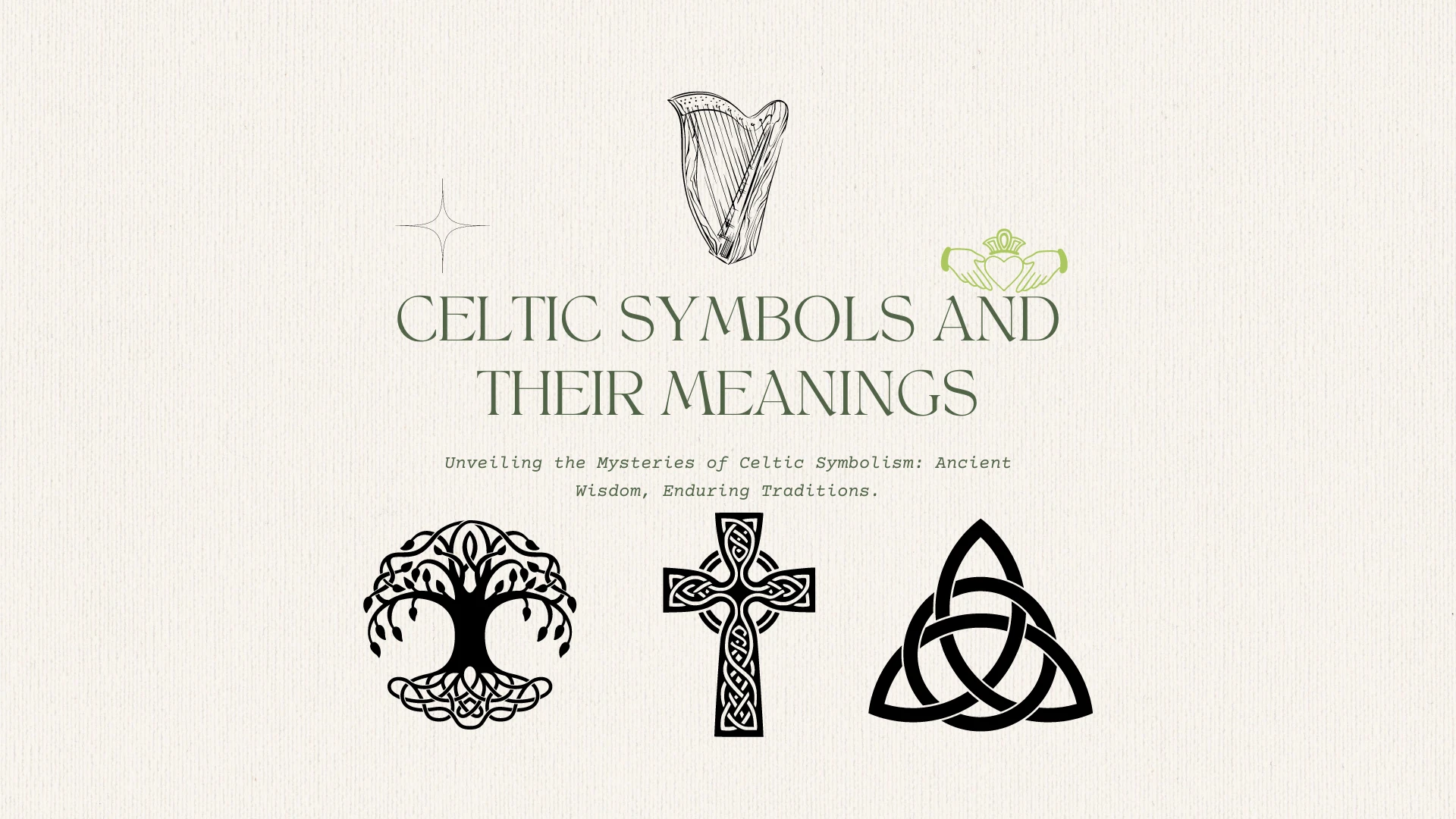
Celtic Symbols That You Will Find In This Article:
- The Awen – Embodying the Harmonious Balance of the Universe
- Brigid’s Cross: A Sacred Symbol of Life-Giving Goddess, Brigid
- The Celtic Cross: Navigating Directions Through Ancient Symbolism
- The Green Man: Celebrating the Lushness of Nature’s Renewal
- The Irish Harp: Melodic Emblem of Ireland’s Heritage
- The Dara Knot: Rooted in Strength and Wisdom of the Oak
- The Shamrock: Ireland’s Emblem of Natural Beauty and Luck
- The Celtic Tree Of Life: Bridging Heaven and Earth in Druidic Belief
- The Trinity Knot: Eternal Symbolism of Spiritual Continuity
- The Triskele: Journeying Through Life’s Threefold Phases
- The Claddagh Ring: Timeless Token of Love, Loyalty, and Friendship
- The Shillelagh: Iconic Irish Symbol of Strength and Resilience
- Quaternary Celtic Knot: Exploring Complexity in Symbolic Unity
- The Celtic Bull: Symbolizing Power and Prosperity in Irish Mythology
- The Ailm Celtic Symbol: Embracing Healing and Renewal in Celtic Lore
- Serch Bythol: Capturing Eternal Love’s Endless Embrace
- Beltane: Welcoming the Vibrancy of Summer’s Arrival in Celtic Tradition
- Celtic Five Fold Symbol: Exploring Sacred Significance in Celtic Spirituality
- The Eternity Knot: Endless Symbolism in Eternal Connectivity
- The Sheela-na-Gig: Ancient Guardian of Fertility and Protection in Celtic Culture
1. The Awen or the Three Rays of Light – Celtic Symbols
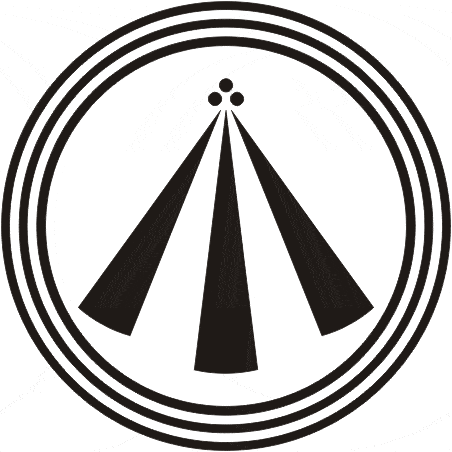
Starting with The Awen, a symbol deeply entrenched in Celtic culture, symbolizes inspiration and essence and has gained popularity in modern designs for tattoos, jewellery, and artwork. Initially attributed to Iolo Morgannwg, an 18th-century Welsh poet, recent studies suggest that the Awen might be older than previously thought, with its first recorded appearance in the 9th-century “Historia Brittonum.”
This neo-Druid symbol beautifully illustrates the harmony of opposites within the universe:
- Key Feature: Awen’s design embodies dynamic equilibrium with two outer rays representing masculine and feminine energies and a central ray signifying balance. This illustrates how opposing forces can coexist and complement each other, a concept that resonates widely within and beyond Celtic traditions.
2. St Brigid’s Cross – Celtic Symbols
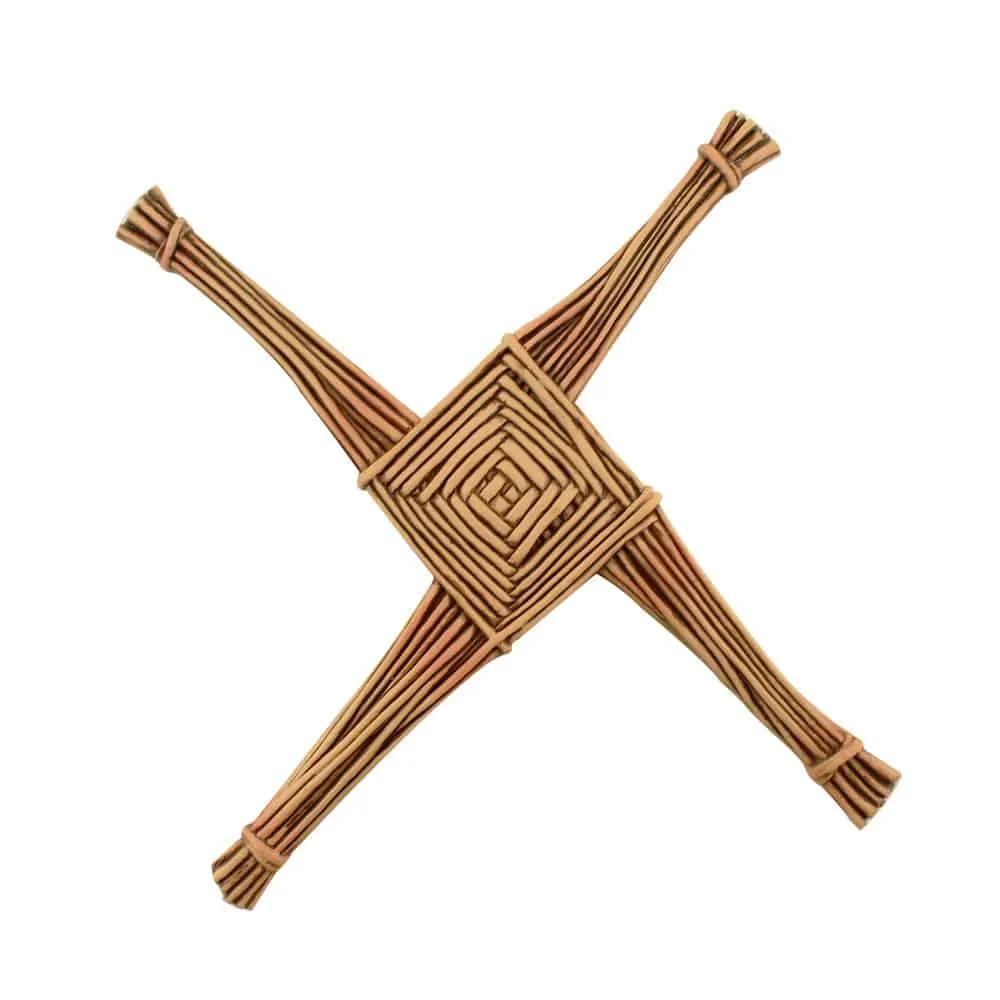
St Brigid’s Cross
Brigid’s Cross is often regarded as a Christian symbol, but its origins trace back to Brigid of the Tuatha de Danaan, a life-giving goddess in Irish Celtic mythology. Traditionally woven from rushes and sometimes straw, this cross is crafted during the feast of Imbolc to celebrate the onset of spring.
Brigid’s Cross is closely associated with St. Brigid of Kildare, a key figure in Irish Christianity, who is thought to have been influenced by the earlier pagan goddess Brigid from Irish mythology. This goddess was associated with spring, fertility, and healing rather than with fire. The transition of Brigid from a goddess to a saint involved blending some pagan practices and symbols, like the making of Brigid’s Cross during Imbolc, into Christian traditions. This cross is traditionally crafted to celebrate the beginning of spring and is said to protect homes from harm.
- Key Feature: Hanging a St. Brigid’s Cross on your wall is believed to offer protection. St. Brigid and St. Patrick are revered as one of Ireland’s patron saints.
For instructions on how to make your own St. Brigid’s Cross, click here.
3. The Celtic Cross – Celtic Symbols
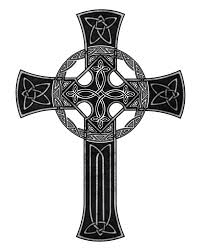
The Celtic Cross is commonly associated with Christianity, yet research indicates that this iconic symbol has predated Christian influence for thousands of years. Originally, the Celtic Cross appeared across various ancient cultures, embodying significant symbolic meanings.
- Key Feature: The Celtic Cross is believed to represent the four cardinal directions or the four essential elements—earth, fire, air, and water, highlighting its deep connection with nature and the universe.
The cross blends rich, powerful symbolism, encapsulating the Celts’ hopes and aspirations. While it has been adopted as a Christian emblem, its origins are firmly rooted in ancient pagan traditions. Today, the distinct shape of the Irish Cross remains widely recognized and celebrated worldwide. You can learn more about the Celtic Cross here.
4. The Green Man – Celtic Symbols
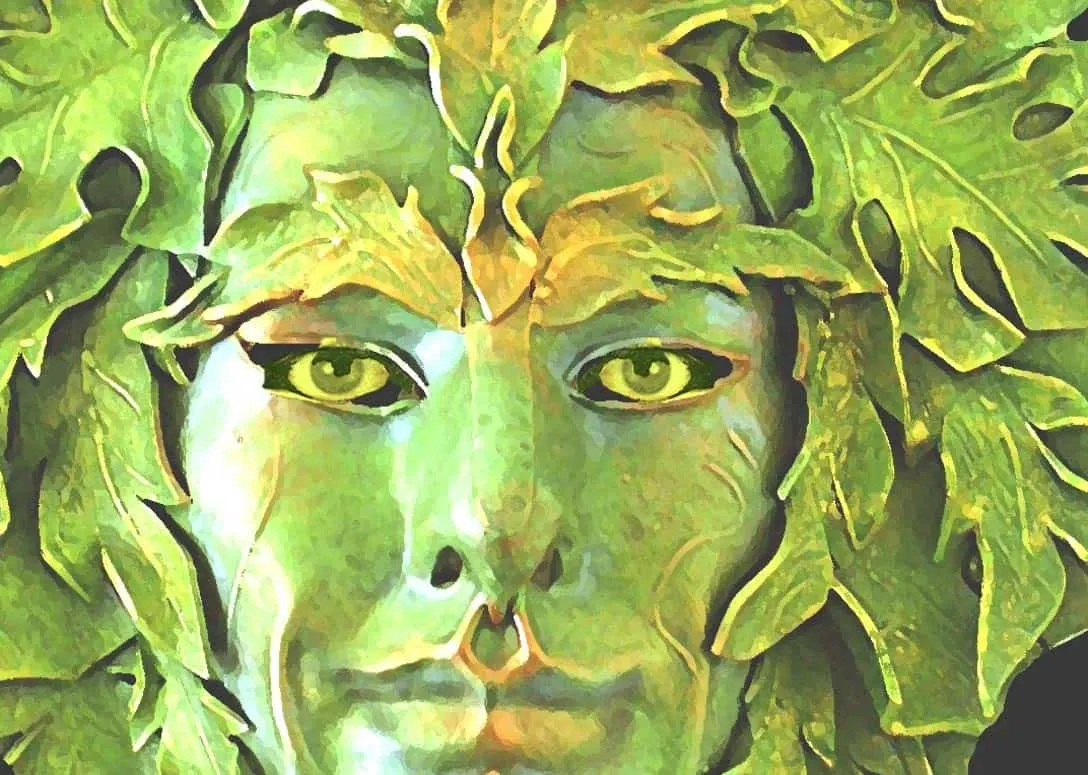
The Green Man, a symbolic figure deeply embedded in various cultures, is typically depicted as a man’s head made of foliage. This symbol is prevalent across many buildings and architectural structures in Ireland and Britain, symbolising rebirth and the intricate interdependence between humans and nature.
The Green Man is often celebrated for representing vegetation’s lushness and heralding spring and summer’s arrival. This motif embodies the growth and renewal cycle fundamental to both nature and human existence.
- Key Feature: The tradition of the Green Man extends beyond mere decoration, serving as a potent symbol of nature’s regenerative powers. It is intricately carved into the fabric of many European Christian churches, illustrating the blend of pagan and Christian symbolism.
A notable example of this integration is seen in the Seven Green Men of Nicosia in Cyprus. This series of carvings, dating back to the thirteenth century, adorns the facade of St Nicholas Church in Nicosia, showcasing the enduring legacy and widespread appeal of the Green Man in medieval religious art. This figure not only enhances the aesthetic value of sacred buildings but also offers a poignant reminder of nature’s role in spiritual and everyday life. You can learn more about the Green Man here.
5. The Irish Harp
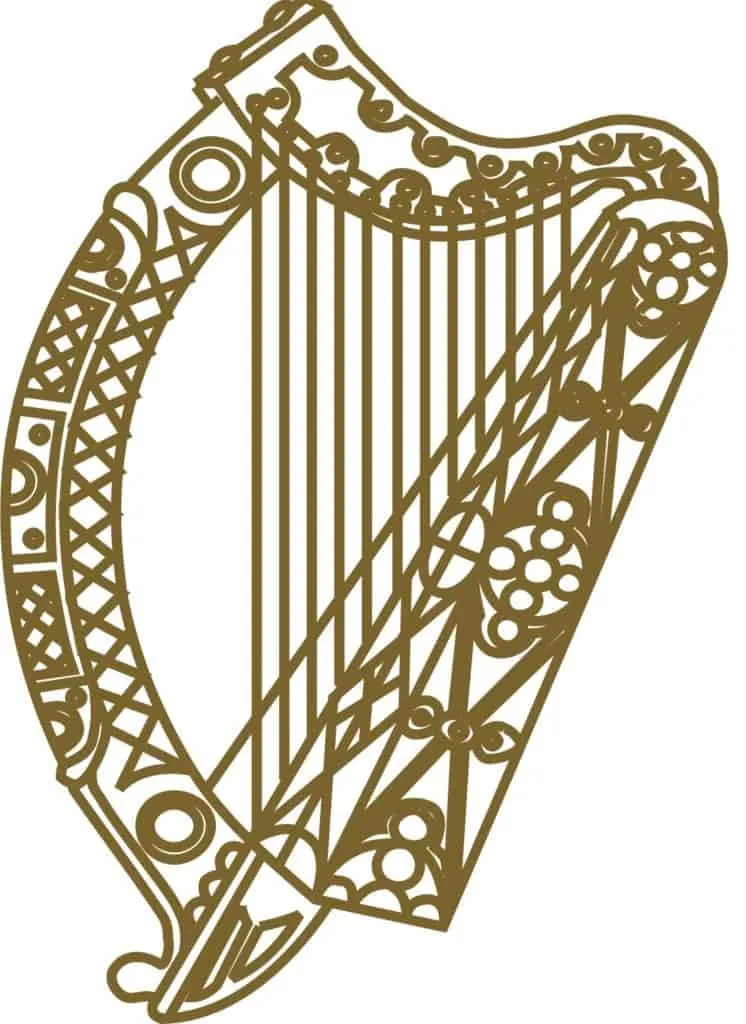
The Irish Harp, distinguished as the national emblem of Ireland, stands alongside the Shamrock as one of the most iconic Irish symbols recognized globally today. This emblem graces the Irish Euro coins and famously adorns the Guinness logo, often regarded as the nation’s unofficial beverage.
Believed to have been introduced to pre-Christian Europe by the Phoenicians from Egypt, the harp has been pivotal in Irish culture since the 10th century, becoming a profound representation of the Irish spirit. Its significance was such that, during the 16th century, the British Crown felt so threatened by the harp that they ordered all harps to be burnt and all harpists executed.
- Key Feature: The Harp remains an indelible symbol of Ireland, deeply ingrained in its cultural identity.
Interestingly, the Harp on the Guinness logo is designed to face the opposite direction of the official emblem of Ireland. While the official “Brian Boru harp” emblem faces to the left and has symbolized Ireland for centuries, the Guinness logo features a harp facing to the right.
This intentional distinction ensured that the Guinness emblem did not replicate the official Irish Harp, adhering to government regulations on using national symbols. This subtle difference ensures compliance with legal standards and allows Guinness to maintain a unique connection to Irish heritage while distinguishing its branding. You can learn more about the Irish Harp here.
6. The Celtic Symbol For Strength – The Dara Knot
Continuing our exploration of Celtic symbols, we delve into the profound significance of those embodying strength. The Celtic knot, notably the revered Dara Knot, emerges as a powerful emblem within Celtic culture.
Inspired by the Irish word for oak tree, “doire,” the Dara Knot pays homage to the mighty oak trees deeply revered in Celtic tradition. These majestic oaks were viewed as potent symbols bridging the earthly realm with the spiritual domain and the realm of ancestors. The oak held the highest reverence among all the trees, symbolizing unparalleled power and resilience.
Key Feature: The Dara Knot, distinguished by its intricate and unbroken lines, profoundly represents strength. Its design, devoid of a discernible beginning or end, mirrors our own journey—firmly rooted yet constantly evolving, akin to the enduring oak tree.
Beyond the Dara Knot, another symbol resonating with strength in Celtic lore is the Triskele or Triskelion. This triple spiral motif carries multifaceted meanings, encompassing personal growth, resilience, and the cyclical nature of existence—embracing the past, present, and future. Both the Dara Knot and the Triskelion stand as cherished symbols in Celtic culture, embodying the enduring spirit and tenacity of the Celts, along with their holistic perspective on life and the cosmos.
Regarding the query about the Celtic symbol for strength, the Dara Knot holds prominence. Rooted in the symbolism of the mighty oak tree, the Dara Knot epitomizes strength within Celtic tradition. However, it’s important to note that the Triskelion also carries significant associations with strength, alongside other concepts such as personal growth and the cyclical nature of time. These symbols—the Dara Knot and the Triskelion—are timeless embodiments of resilience and fortitude in Celtic heritage.
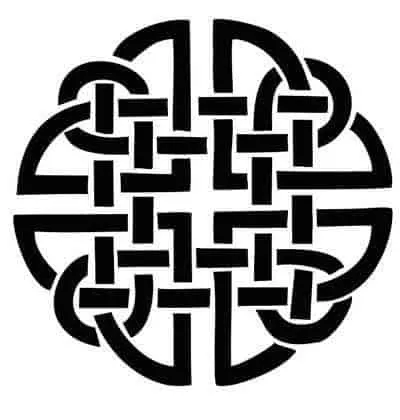
What is the Celtic symbol for strength? The Celtic Symbol for Strength is the Dara knot.
7. The Shamrock
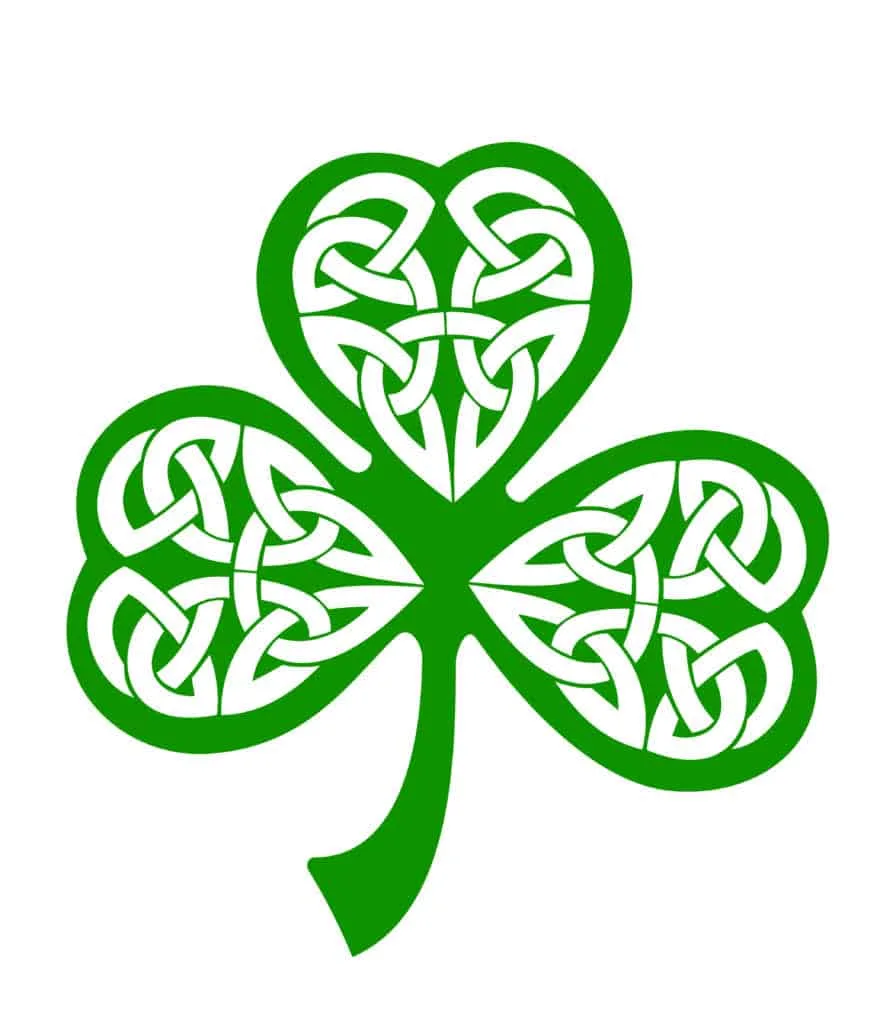
If there’s one symbol widely associated with the Irish and the Irish people, it’s the Shamrock.
Once merely a small clover, it has now bloomed into the national flower of Ireland, proudly worn and cherished by many.
The Shamrock held profound significance for ancient Irish druids, who revered its three heart-shaped leaves as a representation of the triad—a fundamental concept in Celtic belief systems. It stood as a potent symbol, embodying the interconnectedness of various aspects of existence.
Key Feature: Just as the Dara Knot and Triskelion symbolize strength, the Shamrock, too, embodies a powerful concept within Celtic culture—the divine trinity. The triad represented by its three leaves reflects the Celtic belief in the harmonious balance of threefold aspects of life, from the three ages of man to the three dominions of earth, sky, and sea.
Indeed, the Celts found harmony and balance in the notion of threes, believing that essential elements in the world manifested in triads. The Shamrock encapsulated this divine trinity from the three ages of man to the moon’s phases and even the three dominions of earth, sky, and sea.
In Ireland’s tumultuous history, the Shamrock emerged as more than just a botanical emblem. During the 19th century, it became a poignant symbol of Irish nationalism and resistance against British rule. Wearing the Shamrock openly was an act of defiance, often met with severe consequences, including execution.
The Shamrock’s journey from a humble clover to a potent symbol of resilience and rebellion reflects the enduring spirit of the Irish people. To delve deeper into its rich symbolism and historical significance, one can explore its fascinating narrative further. You can learn more about the Shamrock here.
8. The Celtic Tree of Life or Crann Bethadh – Celtic Symbols
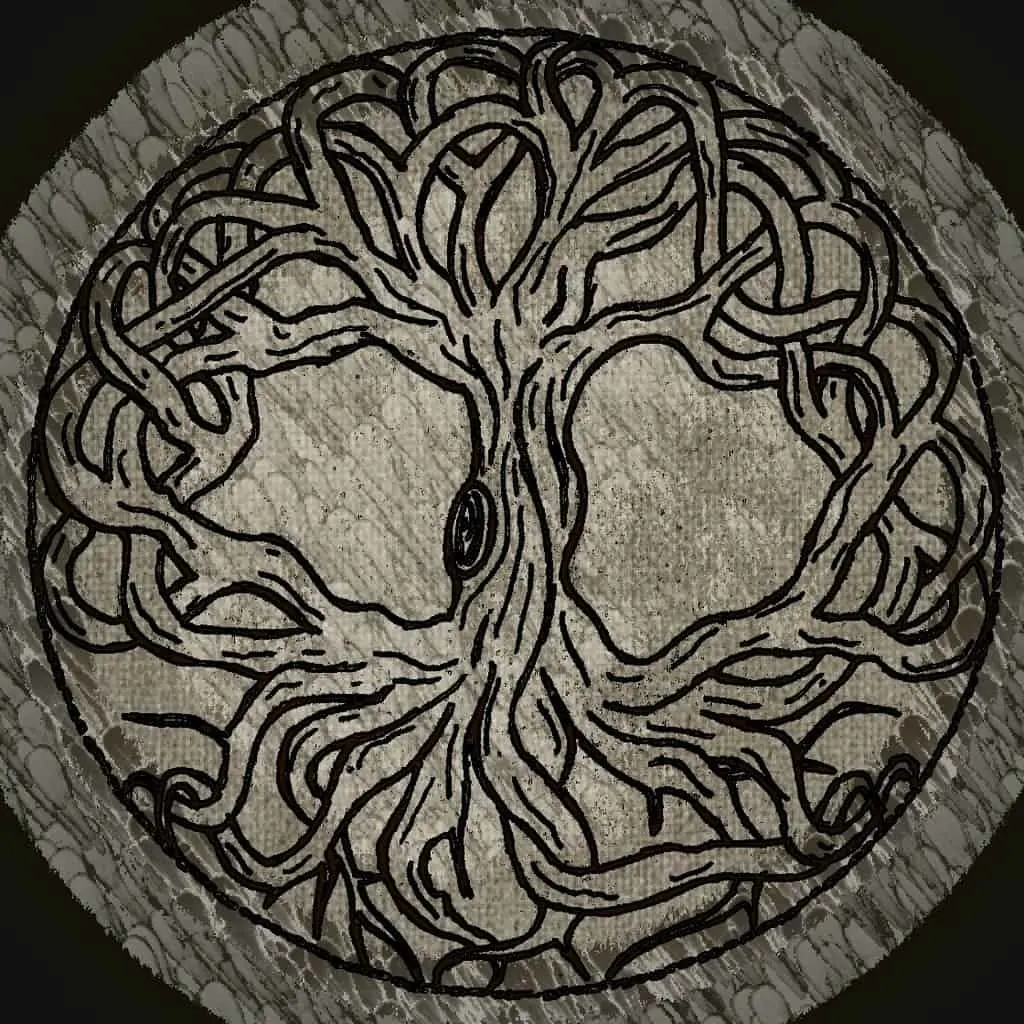
Trees in Celtic culture are often depicted as reaching skyward with branches. At the same time, their roots spread deep into the earth, symbolizing a profound connection between heaven and earth—a belief central to Celtic spirituality.
Key Feature: The Celtic Tree of Life embodies the Druidic belief in the interconnectedness of all things, serving as a powerful symbol of the link between the earthly realm and the spiritual planes.
The Celts revered trees, viewing them as ancestral beings connected to other worlds. The oak tree held the highest sanctity, representing the Axis Mundi—the center of the world. The Celtic word for oak, “Daur,” is etymologically linked to the word “door,” signifying the oak’s role as a gateway to the Otherworld, the realm of the Fairies.
Countless Irish legends intertwine with trees, with tales of individuals falling asleep under a particular tree and awakening in the fairy realm, highlighting the mystical allure of these ancient beings.
Moreover, the symbolism of the Tree of Life extends beyond mere representation; it embodies qualities such as wisdom, strength, and longevity, traits revered by the Celts.
The Celts revered trees beyond symbolism; they believed that cutting down their sacred trees would render their enemies powerless, underscoring the deep spiritual significance attributed to these natural wonders.
Additionally, the Celts drew inspiration from the cyclical changes observed in trees throughout the seasons, deriving the meaning of rebirth from their transformations—from the lush vitality of summer to the quiet introspection of winter.
To delve deeper into the symbolism and significance of the Celtic Tree of Life, one can explore its rich tapestry of meanings and legends.
Here are some interesting facts about the Celtic Tree of Life:
- Trees connected the world of the spirits and the ancestors, living entities, and doorways into other worlds.
- The most sacred tree was the Oaktree, representing the Axis Mundi, the world’s centre.
- The Celtic name for oak, Daur, is the origin of the word door– the oak tree’s root was the doorway to the Otherworld, the realm of Fairy.
- Countless Irish legends revolve around trees. One could fall asleep next to a particular tree and awake in the fairy realm.
- This is why the Tree of Life symbol relates qualities to it, such as wisdom, strength & longevity.
- The Celts believed their enemies would be powerless if their sacred tree were cut down.
- The Celts derived the meaning of rebirth from the seasonal changes they saw each tree undergo (Summer to Winter, and so on).
- You can learn more about the Celtic Tree Of Life here.
9. The Triquetra or the Trinity Knot – The Celtic symbol for love
Like all Celtic knots, the Triquetra is intricately crafted from a single continuous line, weaving in and out of itself in a mesmerizing pattern.
Key Feature: The Triquetra symbolizes eternal spiritual life, embodying a concept of existence with no discernible beginning or end, reflecting the boundless nature of the divine.
Though often associated with Christianity, with speculation that it was introduced by monks during attempts to convert the Celts, the Triquetra predates this association. It holds the distinction of being one of the oldest symbols of spirituality, serving as a potent emblem in Celtic culture long before the arrival of Christianity.
Moreover, the Triquetra holds multiple layers of symbolism within the Celtic tradition. Beyond its representation of eternal life, it also serves as a symbol of love—the Celtic symbol for unconditional love, known as the Trinity Knot. With its interwoven pattern and endless design, the Triquetra embodies the timeless essence of love and affection, symbolizing enduring bonds and infinite devotion.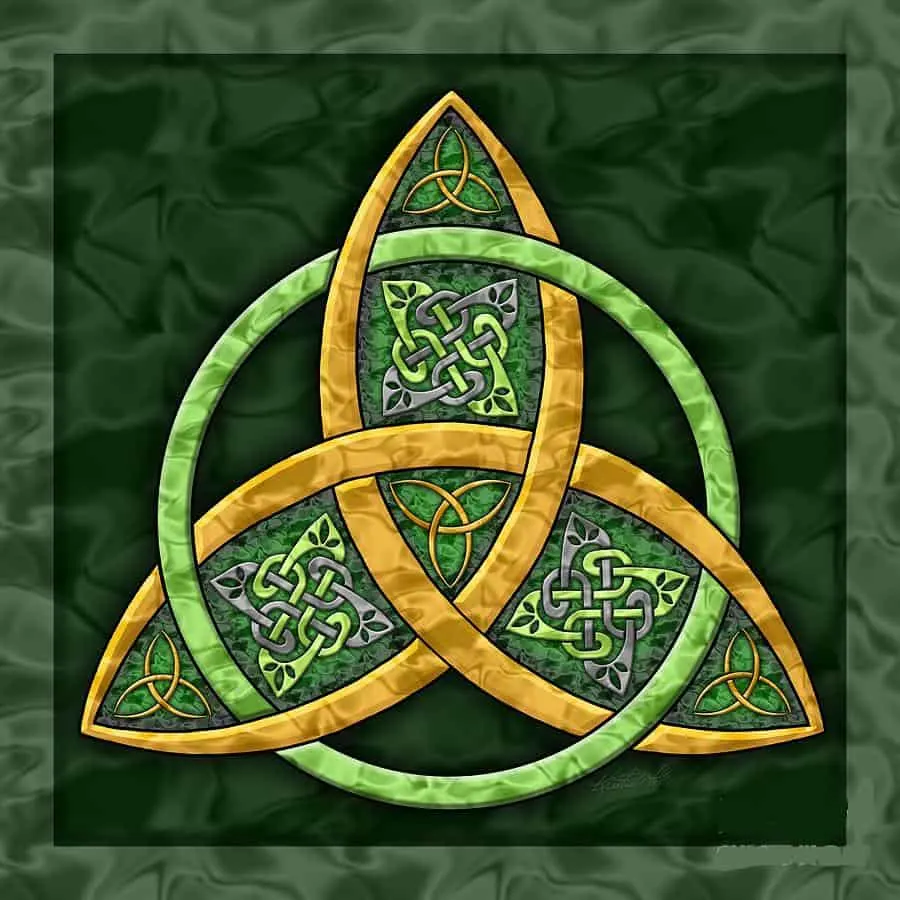
Dating back to the ninth century, the Triquetra appears in the Book of Kells as a decorative motif devoid of specific religious connotations. Its presence in Norwegian churches dating to the 11th century further attests to its widespread significance and enduring appeal across different cultures and periods.
The significance of the Triquetra aligns seamlessly with Celtic beliefs in the power of threes, reflecting the harmony and balance found in the interconnected aspects of existence.
Indeed, the Triquetra’s influence extends beyond ancient symbolism. It makes appearances in modern culture, including its depiction as Thor’s Hammer in contemporary films—a testament to its enduring relevance and timeless allure. You can learn more about the Triquetra here.
You might recognise it from Thor’s Hammer in the modern-day movie. One of my favourite Marvel movies!
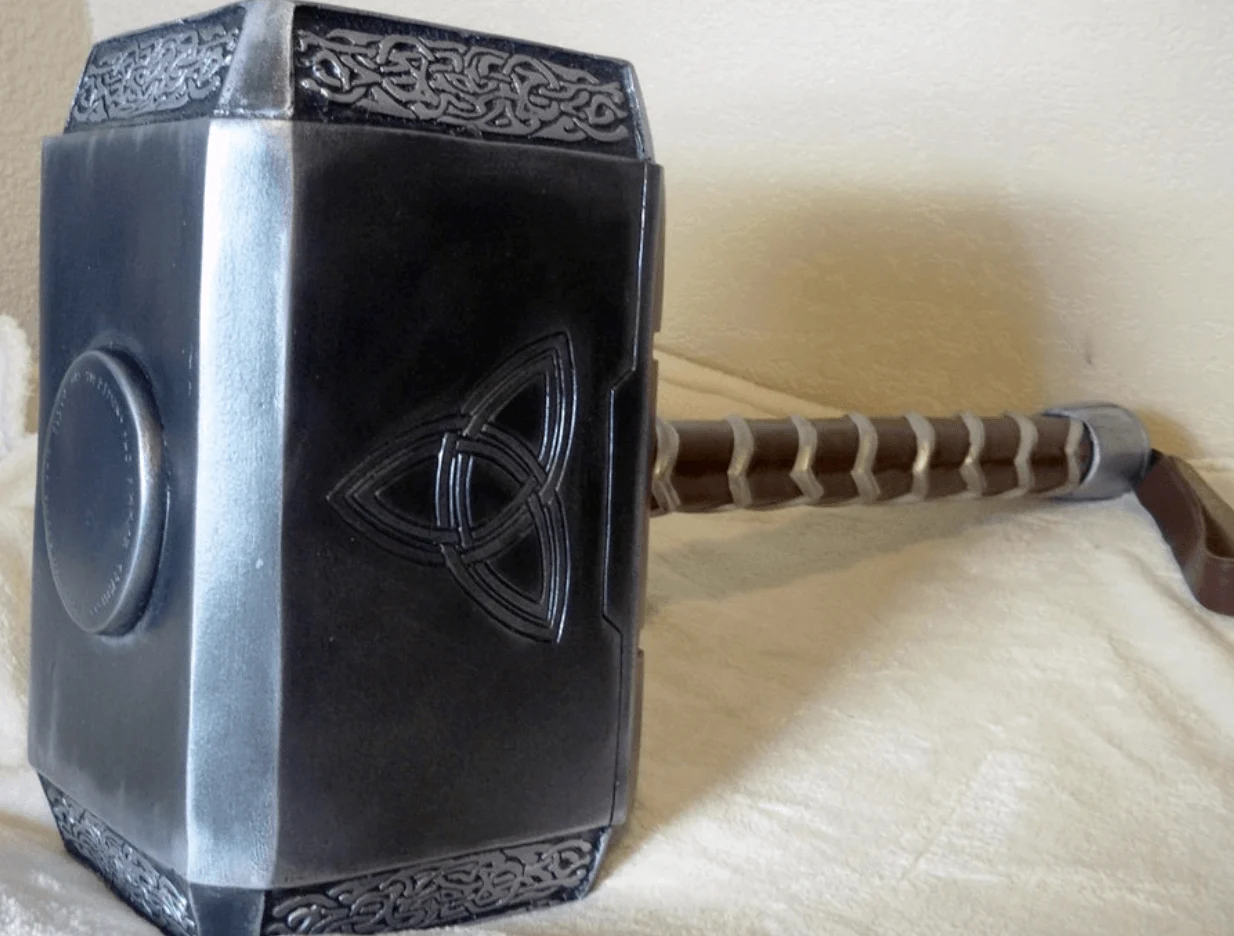
Thor’s Hammer shows the Celtic sign for love and strength.
10. The Triskele – Celtic Symbols

Another Irish symbol embodying the Celtic belief in the triad is the Triskele, also known as the Triskelion.
Key Feature: The Triskele, one of the oldest Irish symbols, holds profound significance in Celtic culture. It represents the interconnected aspects of life and the cyclical nature of existence.
Numerous Triskele carvings adorn the kerbstones of Newgrange, a Neolithic monument dating back to around 3200 BC, making them some of the earliest examples of this symbol’s use.
Evidence of the Triskele’s presence extends beyond Ireland, with similar motifs discovered in various cultures worldwide. One striking example is found in Athens, Greece, as depicted in the image below, illustrating this ancient symbol’s universal appeal and enduring significance.
The Triskele’s enduring presence across different cultures and periods highlights its timeless allure and profound symbolism, serving as a potent reminder of the interconnectedness of all things and the eternal rhythms of life. You can learn more about the Triskele here.
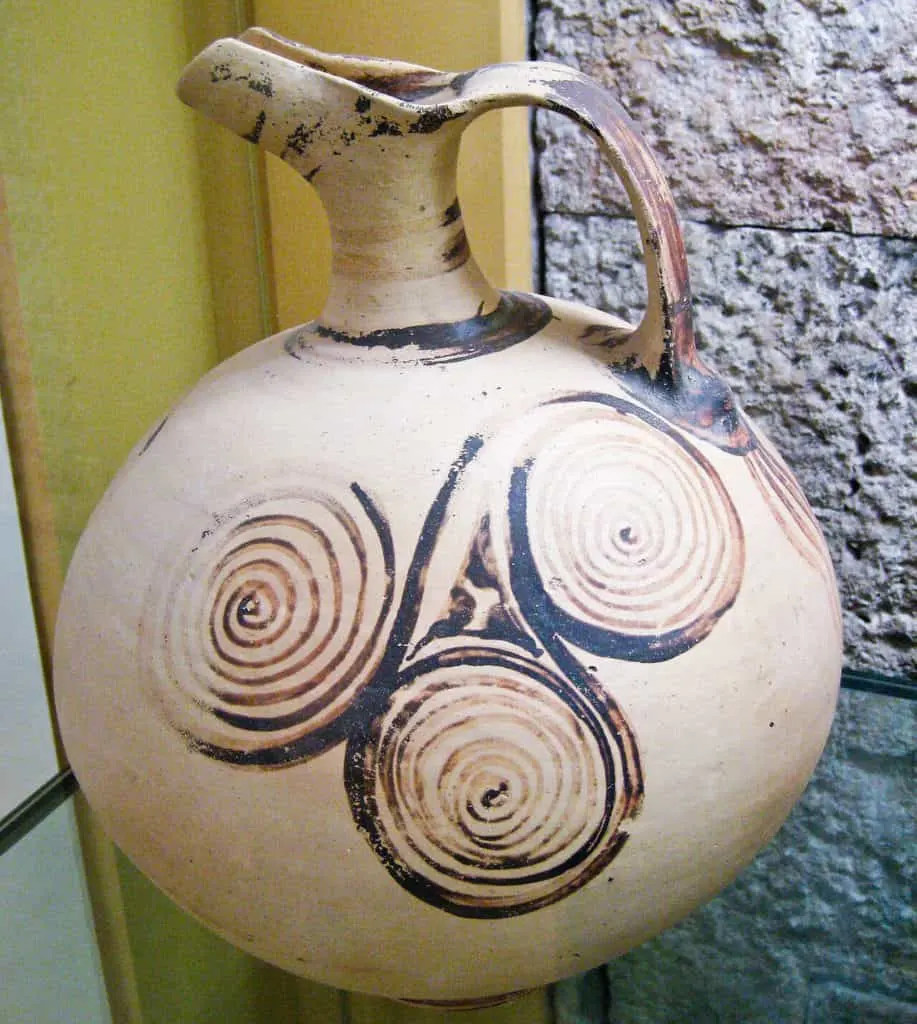
Beaked jug (ewer) decorated with triple spirals. Late Helladic III, 1400-1350 BC
The spirals could have changed over the centuries, but the base meanings include:
- There are three stages of life: life, death, and rebirth
- Three elements: the Father, the Son, and the Holy Spirit
- Three domains: earth, sea and sky, past, present and future.
11. The Claddagh Ring – Popular Celtic Symbols
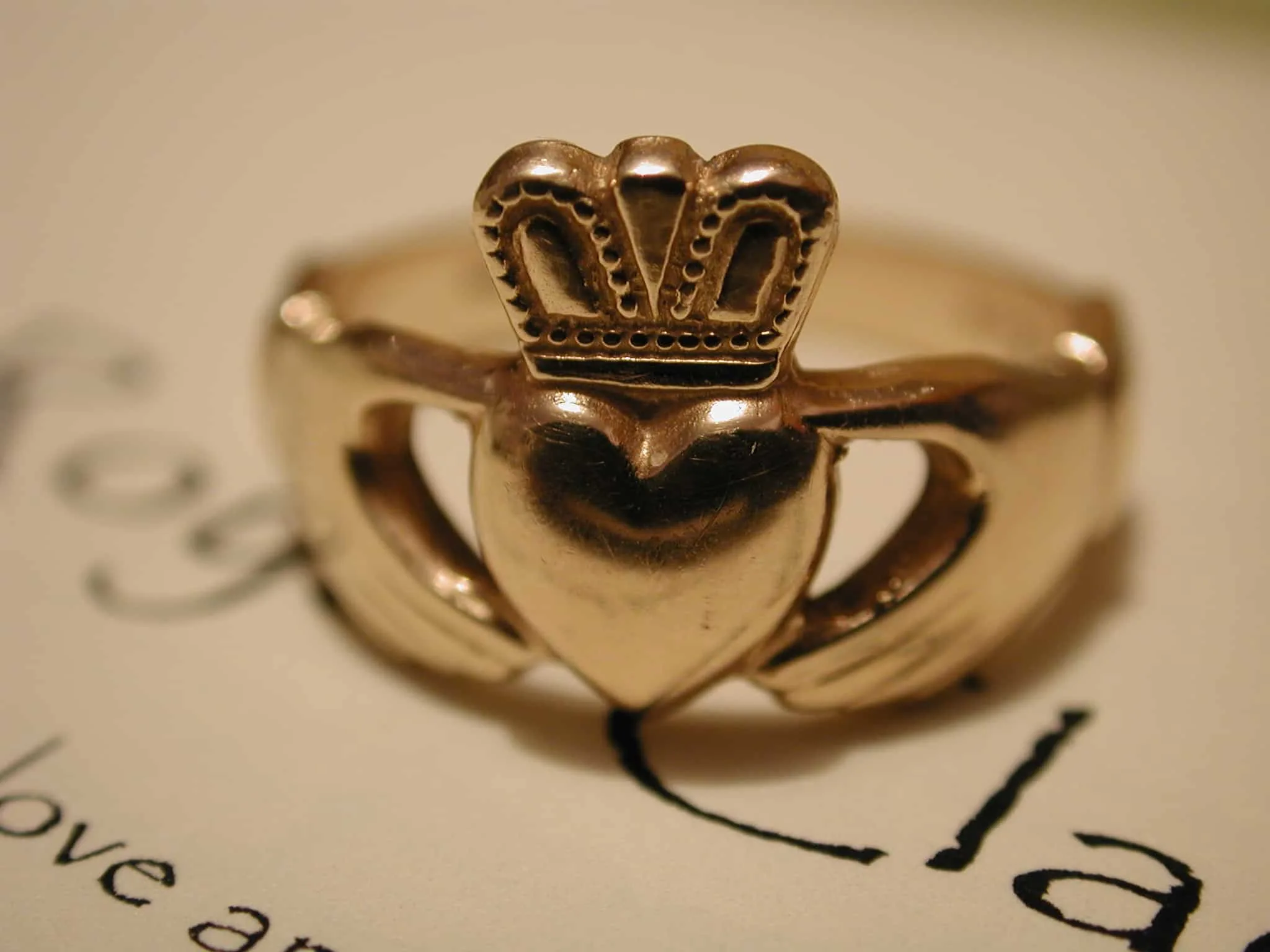
In Irish tradition, the Claddagh ring (Irish: fáinne Chladaigh) is a cherished symbol of love, loyalty, and friendship. Each element of its design carries profound significance—the hands symbolize friendship, the heart embodies love, and the crown represents loyalty.
Originating from the village of Claddagh on the coast of Ireland, the name “Claddagh” derives from the Irish phrase “An Cladch,” meaning “flat stony shore.” The addition of the ‘GH’ ending accommodates phonetic English speakers, capturing the guttural sound of the Irish language.
According to legend, Richard Joyce, a fisherman from the village of Claddagh near Galway, crafted the first Claddagh ring for his beloved. Despite enduring hardships, including being kidnapped by pirates and sold into slavery, Joyce remained steadfast in his love, eventually reuniting with his betrothed and marrying her.
The Claddagh ring holds not only sentimental value but also serves as a means of communication through its various wearings:
- The heart pointing toward the fingertips on the right hand signifies the wearer’s availability and openness to love.
- The right hand with the heart pointing toward the wrist indicates the wearer is in a committed relationship.
- Engagement is symbolized by wearing the ring on the left hand with the heart facing outward toward the fingertips.
- When worn on the left hand with the heart pointing toward the wrist, it signifies marriage.
You can learn more about the Claddagh ring here.
Some celebrities, including Julia Roberts, Walt Disney, and Jennifer Aniston, have worn the Claddagh ring. Read the post on the celebrities wearing the Claddagh ring here.
12. The Shillelagh – The Irish fighting stick
The Shillelagh, pronounced “shi-ley-li,” is a traditional Irish stick crafted from blackthorn wood, featuring a distinctive thickening at its upper end.
Known by various names, including “bata” in Gaelic, which translates to “fighting stick,” the Shillelagh has a rich history intertwined with Irish culture and heritage.
The name “Shillelagh” comes from the Shillelagh Forest in County Wicklow, which is renowned for its abundant stands of fine oaks. Unfortunately, many of these majestic oaks were felled and exported to different parts of Europe over time.
Initially utilized for settling disputes gentlemanly, akin to duels with pistols or swords, the Shillelagh served as a symbol of honour and resolve.
In terms of appearance, Shillelaghs manifest in various forms. They can be fashioned as walking sticks, boasting lengths of up to 100 cm, or as compact weapons characterized by a sturdy and concise design, ideal for self-defence or combat.
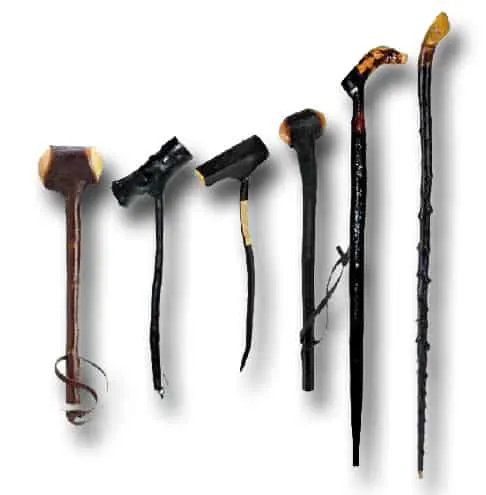
13. Quaternary Celtic Knot – Celtic Protection Symbols
Meaning: Quaternary simply means “four” – in this case – four-cornered.
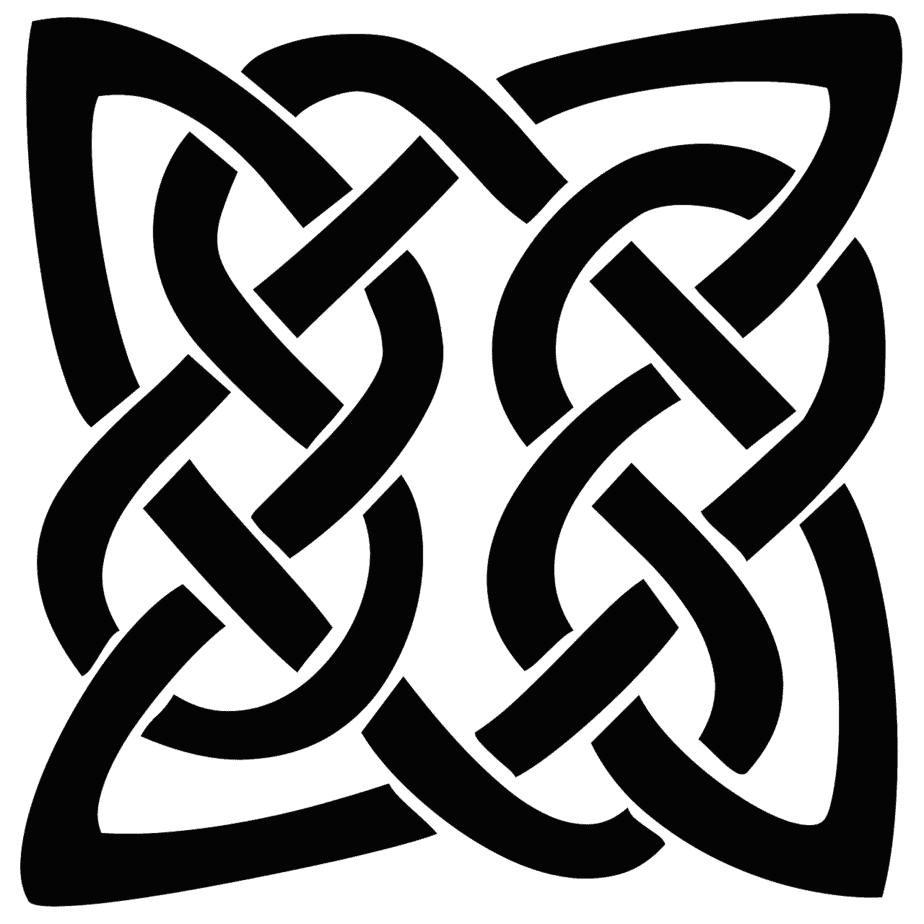
Celtic Quaternary knot means four-sided or four.
As the name suggests, the Quaternary Celtic knot embodies the concept of “four,” reflecting its four-cornered design. This knot intricately combines elements from various Celtic knots, including the sailor knot, the Dara knot, and a shield knot, resulting in a unique and visually striking pattern.
While the exact symbolism of the Quaternary Celtic knot may spark endless debates, several interpretations resonate deeply with Celtic lore and culture. Some believe it represents the four cardinal directions—North, South, East, and West—symbolizing guidance and navigation through life’s journey. Others associate it with the four Latin Gospels in the revered Book of Kells, signifying divine wisdom and spiritual enlightenment.
Furthermore, the Quaternary knot may symbolize the four sacred Celtic festivals—Samhain, Beltane, Imbolc, and Lughnasadh—marking the changing seasons and the eternal cycle of life and renewal. It can also represent the four elements—Earth, Fire, Water, and Air—signifying the interconnectedness of all natural phenomena.
While some interpretations may seem lighthearted, such as comparing it to a Rubik’s Cube, the Quaternary Celtic knot remains a deeply meaningful symbol, rich in cultural heritage and significance. Its versatility and diverse interpretations make it a popular choice for Celtic tattoos, reflecting individual beliefs, values, and connections to Celtic tradition.
But a few possibilities are:
- The four Directions, North South East West
- The four Latin Gospels in the Book of Kells
- The four Celtic festivals Samhain, Beltane, Imbolc, Lughnasadh
- The four seasons, Winter, Spring, Summer, Fall
- The four elements are Earth, Fire, Water Air
Technically, you could make an argument for anything with four sides—even a Rubix cube(haha, just joking).
Key Feature: The Quaternary Celtic knot’s distinctive four-sided structure serves as a potent symbol, representing the significance of the number four in Celtic culture and spirituality.
The Quaternary Celtic knot is very popular with Celtic tattoos because of its diverse meanings. Depending on the era, the Celtic symbol could mean different things.

Another version of the Celtic knot with four sides
14. The Celtic Bull Meaning And Mythology
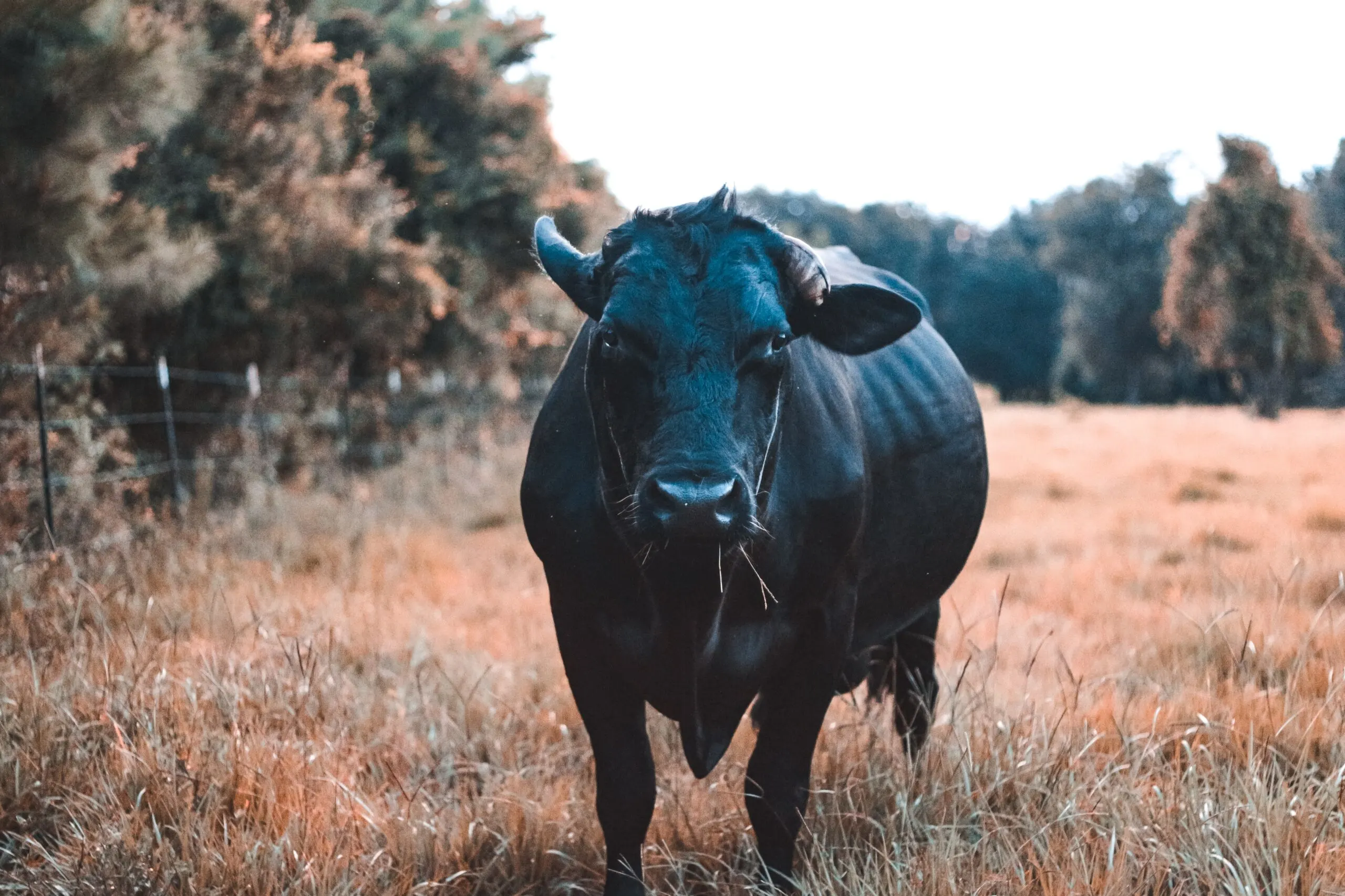
The Celtic Bull stands as a revered symbol of strength and vitality in Celtic mythology, often associated with the greatest Celtic warriors and their most potent animal counterparts.
Throughout Celtic culture, animals held significant symbolism and were prominently featured in various forms of art and adornment, including jewellery, tapestries, carvings, and clothing.
Key Feature: The Celtic Bull embodies virtues of strength, fearlessness, and strong will, serving as a potent symbol of power and fertility. While Celtic men sought to embody these attributes through the bull’s symbolism, it also held significance as a symbol of fertility for women.
Interestingly, the bull’s symbolism extends beyond strength to encompass wealth, reflecting its vital role as a food source for Celtic villages and its integral contribution to the ecosystem.
In contemporary society, the bull’s symbolism remains potent, particularly in tattoos, where it symbolizes masculinity, strength, and resilience. The iconic bull statue on Wall Street further underscores the enduring significance of this majestic creature, transcending time and culture.

The Celtic bull tattoo
15. The Ailm – The Celtic Symbol For Strength
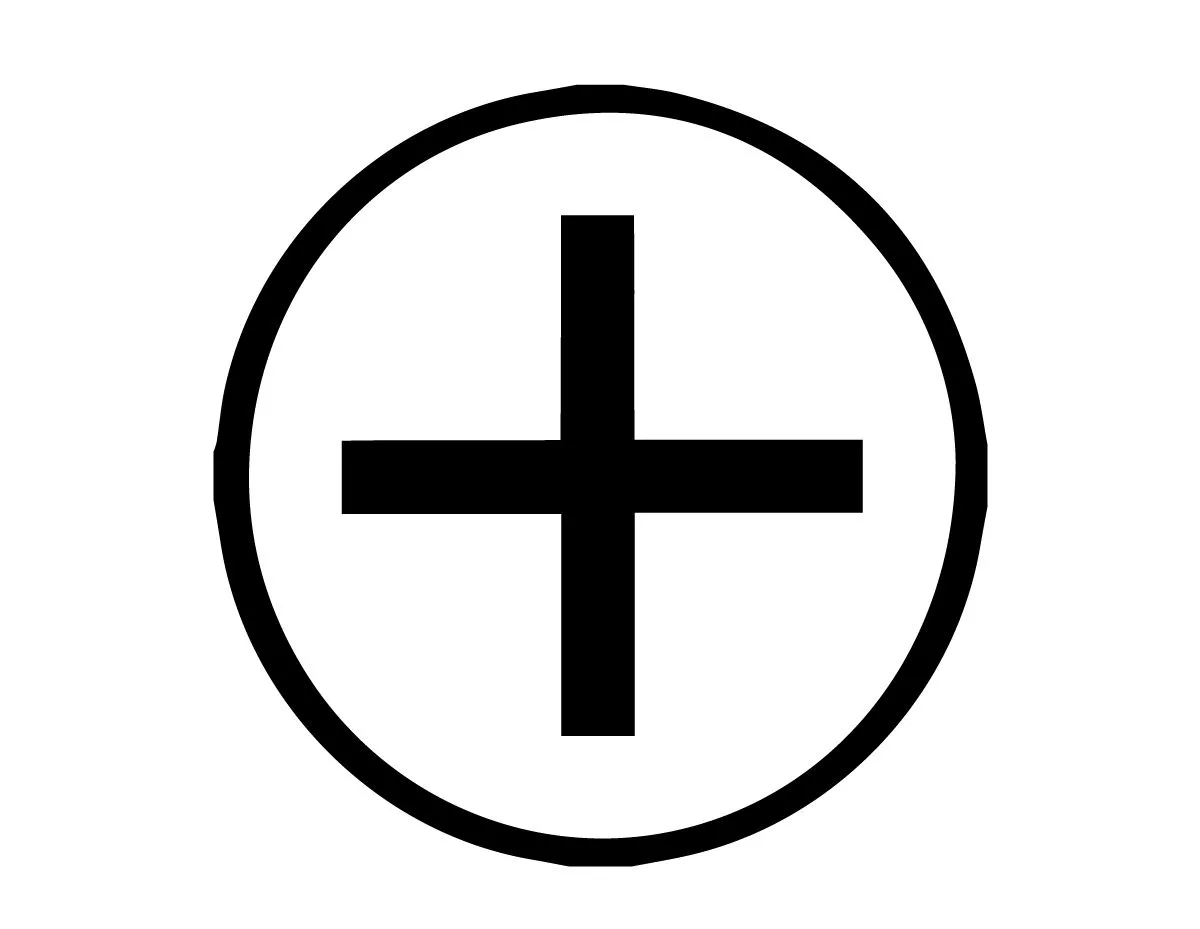
Indeed, both the Dara knot and the Ailm symbolize strength within Celtic culture, yet they each carry distinct meanings and associations.
The Ailm symbol finds its roots in the Celtic Ogham alphabet, specifically derived from the letter “A.” It represents not only strength but also endurance and resilience. The word “Ailm” is thought to refer to “conifer” or “silver fir,” linking it symbolically to evergreen trees associated with healing and renewal of the soul in Celtic tree lore.
Key Feature: The Ailm symbol holds a special significance as one of the most critical Celtic symbols, revered for its positive connotations and associations with strength and spiritual healing.
Furthermore, the Ailm symbolizes the enduring spirit of the Celtic people, reflecting their resilience in the face of challenges and their ability to endure hardships with fortitude.
Today, the Ailm symbol resonates with many, its powerful symbolism transcending time and culture. Unsurprisingly, numerous symbols and brands draw upon its positive connotations to evoke strength, endurance, and resilience in their messaging and imagery.
16. Serch Bythol – The Celtic symbol for everlasting love – Celtic Symbols
The Celtic symbol of everlasting love, comprised of two triskeles, carries profound symbolism and beauty.
Each triskele, with its three-cornered knots, represents the three aspects of two individuals: body, mind, and spirit. When these two triskeles are joined together, they form a circle, symbolizing the endless cycle of eternity and the unbreakable bond of love.
Key Feature: The joining of the two triskeles not only creates a circle but also signifies the merging of two souls, intertwining their destinies and forming an eternal connection.
This symbol serves as a meaningful and visually stunning gift, embodying the depth of love and the timeless nature of relationships.
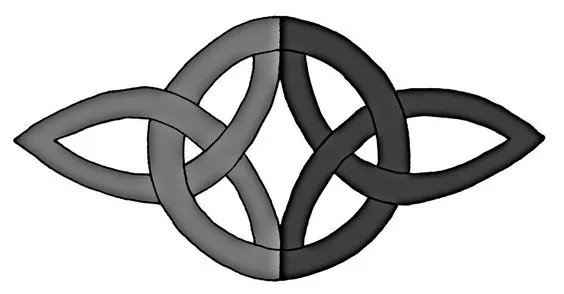
17. Beltane – The Celtic symbol for the start of summer
Beltane, often called May Day, marks the Celtic celebration of the arrival of summer—a joyous occasion cherished by many.
Key Feature: The most iconic symbol of Beltane is the Maypole, embodying the spirit of renewal and vitality associated with the season. Young Celts would venture into the woods to select the straightest tree, often pine or birch, with great ceremony. Once chosen, they would ceremoniously cut down the tree, bring it back to the village, and erect it on the village green.
Beltane is typically celebrated on May 1st, approximately halfway between the spring equinox and the summer solstice. It’s a time of communal gatherings, lively festivities, and reverence for nature’s abundance as the land awakens with vibrant life.
During Beltane, rituals and ceremonies were performed to honour the fertility of the land and ensure a bountiful harvest. Bonfires were lit to symbolize the sun’s power and to purify and protect the community. People would dance around the Maypole, weaving colourful ribbons in intricate patterns as a symbol of unity and the intertwining of life’s energies.
Beltane is not only a celebration of the changing seasons but also a time to connect with the rhythms of nature and to reaffirm our bond with the earth and all living beings.
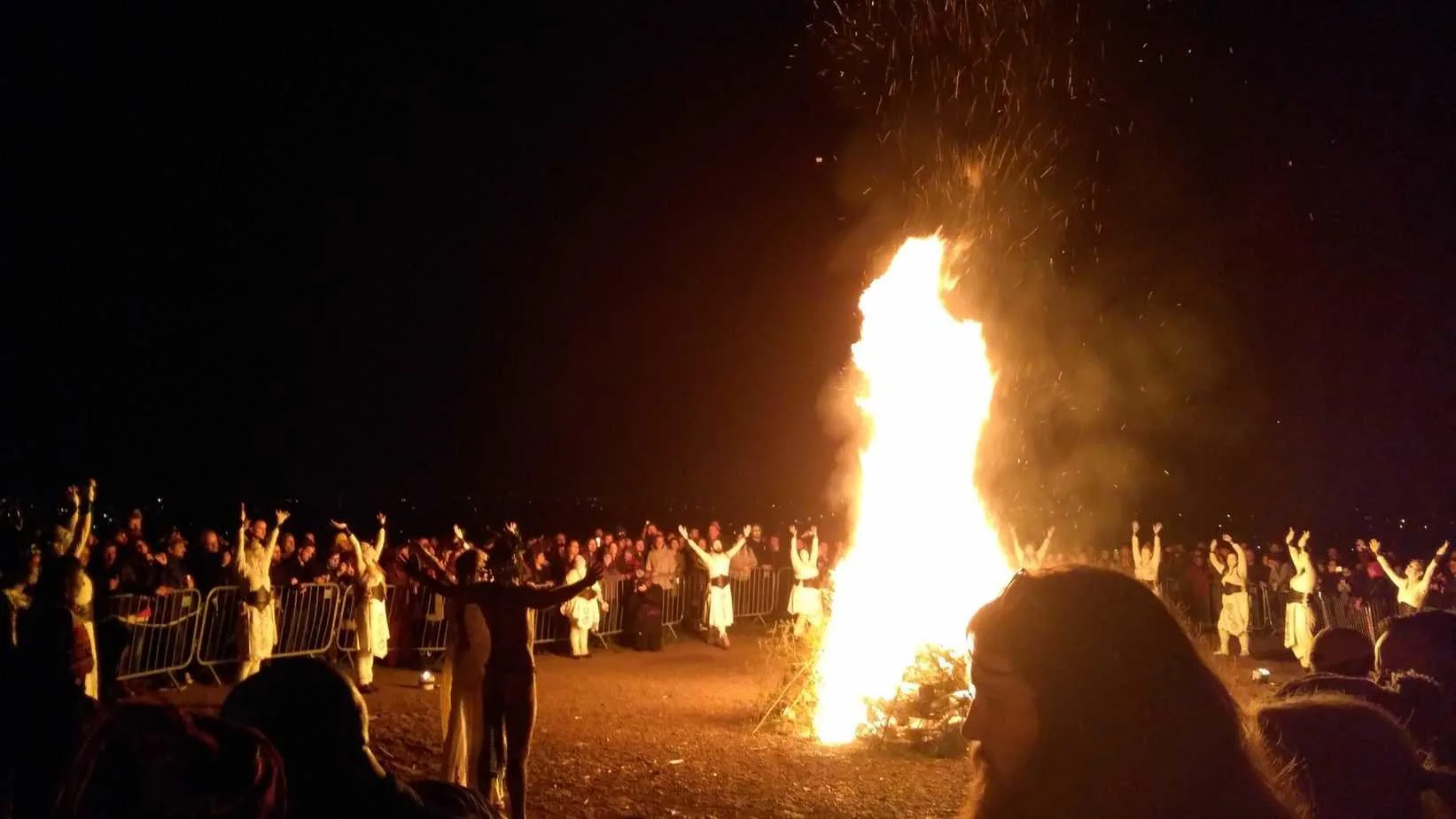
18. The Celtic Five Fold – Celtic Symbols
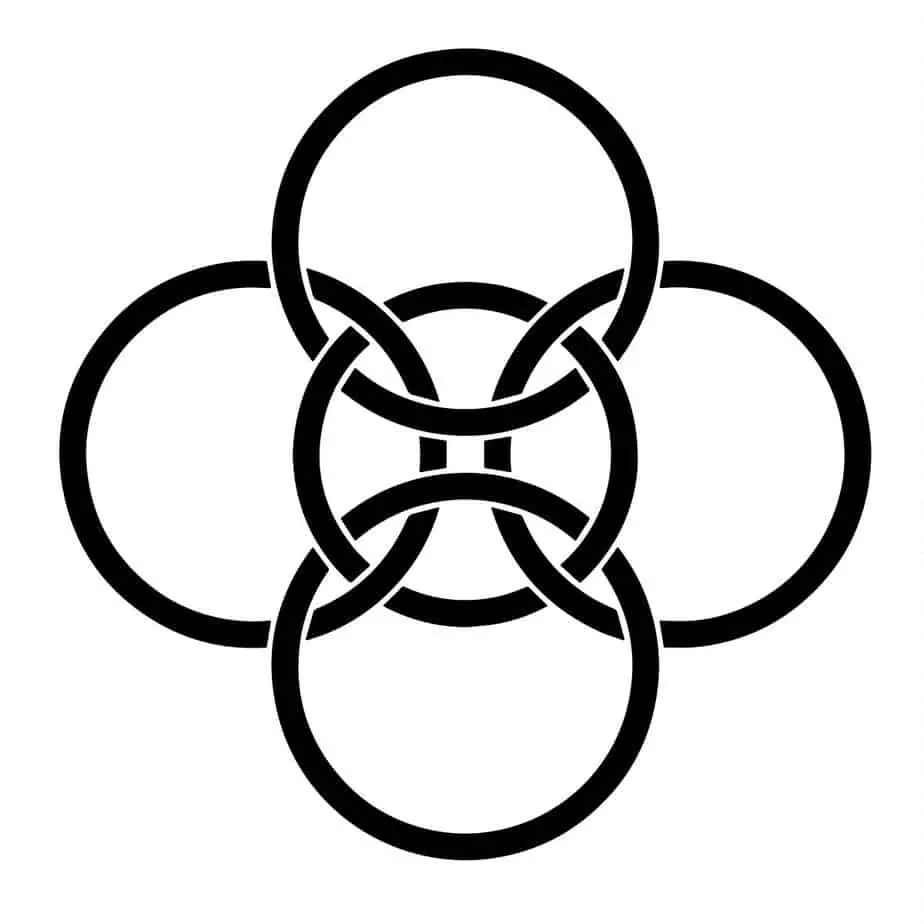
A Typical Celtic Five-Fold Symbol
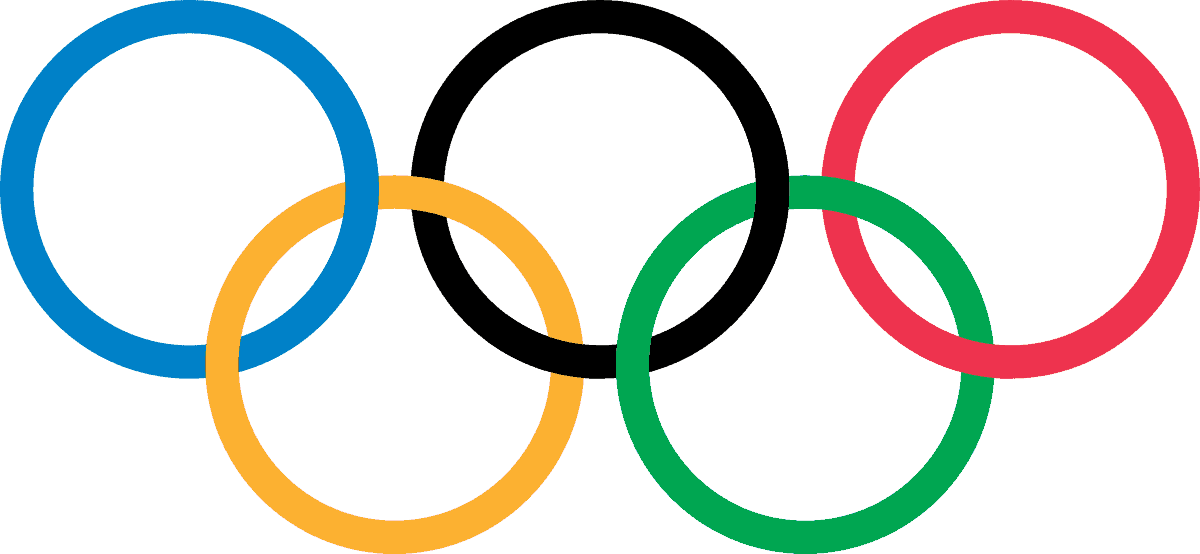
The very similar Olympic rings
19. The Eternity Knot or Endless knot
This is an interesting one. It overlays many other histories and is even seen in Tibetan Buddhism. Their understanding of it is pretty similar to the Celts’. Because the knot has no beginning and no end, the eternal knot symbolises the Buddha’s endless wisdom and compassion—or, in the Celts’ case, the circle of life. 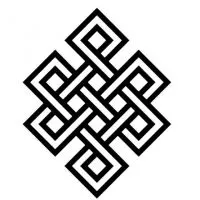
The Eternal Knot, a symbol transcending cultures and histories, is profoundly significant in Celtic and Tibetan Buddhist traditions.
Key Feature: With its seamless design lacking a clear beginning or end, the Eternal Knot symbolizes the eternal wisdom and compassion of the Buddha in Tibetan Buddhism, and in Celtic belief, it represents the endless cycle of life, love, and interconnectedness.
The Celtic interpretation of the Eternal Knot expands its symbolism to encompass various aspects of existence:
- Eternity and Interconnectedness: The knot represents the eternal nature of the world and the interconnectedness of all life forms, symbolizing the continuous flow of existence and the cyclical nature of life, love, friendships, and relationships.
- Central Triskelion: At the heart of the Eternal Knot rests a Celtic triskelion, adding layers of symbolism related to movement, progress, and spiritual evolution.
The Eternal Knot holds multiple interpretations in Tibetan Buddhism, reflecting its rich and complex symbolism:
- Samsara and Endless Cycle: In Tibetan Buddhism, the Eternal Knot symbolizes Samsara—the endless cycle of suffering or birth, death, and rebirth—highlighting the impermanent nature of existence and the quest for enlightenment.
- Union of Opposing Forces: It represents the interplay and interaction of opposing forces in the dualistic world, leading to their union and, ultimately, harmony in the universe.
- Wisdom and Method: The knot embodies the union of wisdom and method, emphasizing the interconnectedness of all things and the path to enlightenment.
- Emptiness and Dependent Origination: It signifies the inseparability of emptiness (shunyata) and dependent origination, revealing the underlying reality of existence.
- Symbolic Linking: The knot symbolizes the linkage between ancestors and omnipresence, reflecting the mutual dependence of religious doctrine and secular affairs.
With its profound symbolism and diverse interpretations, the Eternal Knot serves as a powerful reminder of the eternal wisdom and interconnectedness of all things. It transcends cultural boundaries and resonates with seekers of spiritual enlightenment throughout the ages.
20. St Brigid’s Cross – Officially 1 February, the last of my list of Celtic symbols
The Sheela-na-Gig is a captivating and enigmatic symbol deeply rooted in Celtic mythology and medieval European culture. Often found adorning the walls of medieval churches and castles across Ireland and Britain, the Sheela-na-Gig is depicted as a female figure with exaggerated genitals, often prominently displayed.
Key Feature: Despite its striking and sometimes provocative appearance, the Sheela-na-Gig holds profound significance in Celtic symbolism. It represents fertility, protection, and the power to ward off evil spirits. Its presence in medieval architecture suggests a fusion of pagan and Christian beliefs, symbolizing the eternal cycle of life and the protective power of the divine feminine.
Interpretations of the Sheela-na-Gig vary. Some view it as a symbol of female empowerment and liberation, while others see it as a representation of the primordial mother goddess and the life-giving force of nature. Its exaggerated features may also warn against lust and temptation, emphasizing the importance of spiritual purity and self-discipline.
The Sheela-na-Gig continues to intrigue and captivate scholars and enthusiasts alike, inspiring interpretations and discussions about its origins and meaning. As a symbol of fertility, protection, and the divine feminine, it remains an enduring emblem of Celtic culture and mythology, inviting us to explore the depths of the human experience and the mysteries of the ancient world.
Final thoughts on these Celtic Symbols:
As we conclude our exploration of these fascinating Celtic symbols, we are reminded of the rich tapestry of culture, mythology, and spirituality woven throughout the Celtic tradition. From the enduring wisdom of the Awen to the protective power of St. Brigid’s Cross, each symbol offers a glimpse into the depth and complexity of Celtic heritage.
Through the centuries, these symbols have served as potent reminders of the interconnectedness of all things and the enduring values of love, loyalty, and harmony with nature. Whether depicted in intricate knotwork, carved in stone, or woven into ancient tales, they inspire and captivate us today.
As we reflect on the significance of these symbols, let us honour the wisdom of our ancestors and the timeless truths they sought to convey. May we carry their legacy forward with reverence and respect, embracing the beauty and mystery of the Celtic tradition for generations to come.
Thanks for reading, and be sure to share if you find this information useful.
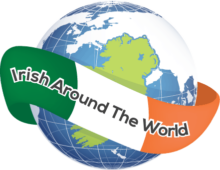
Robert Beard
Friday 20th of May 2022
I am one of the many people around the world that has lost their heritage. I tried to sign up for the weekly letter, no luck. Are there other clubs, groups, books that insist on factual celtic information, history?
Angelina
Wednesday 19th of January 2022
This article was great! It gave very quick overviews with easy links to more information. I really like how it was written, it was like reading someone's notes. I loved it! Keep up the amazing work! - angelina.all.over
Gina Keenan-Williams
Friday 11th of March 2022
@Angelina, I live on a little island in the South Pacific & this article has enabled me to intertwine Celtic symbols with polynesian motiffs on a 21st birthday carving for my daughter based on her ancestry. Very meaningful & insightful. Love it💚
Irish Around The World
Wednesday 19th of January 2022
Glad you enjoy the post. Yes, it was put together over many years and I always tried to add more without adding too much if that makes sense haha. I will be always updating the Celtic Symbols post so be sure to pop back when you get a chance :)
Tonja
Wednesday 3rd of November 2021
I recently bought a Celtic crosses at a garage sale. It has symbols of people, angels, animals & a harp. I'm wondering what this cross or the symbols on it represent?
Sus
Monday 7th of June 2021
I am looking for the Celtic symbol for honesty. Want to be sure I have the correct symbol. Would you know?
Beth John
Sunday 11th of April 2021
Hi. I have a celtic symbol which I am hoping an expert can take a look at and maybe give me some information about its meaning (or absolutely anything at all!) I'll leave my email below and if you're happy to I can send over a picture of the symbol! I really appreciate any help at all, so thank you!!!